Description
The scene is set on a hill, with Florence in the background. It features a man, whose legs are tied by a serpent, who closes to an aged one, dressing in red and sitting near a tree. The latter is holding several lightnings. Next to the walking man is a small stoat, a symbol of purity.
The same character, with the serpent getting out from his jacket and looking at him, has fallen in the foreground. An inscription gets out from his mouth, saying NULLA DETERIOR PESTIS QUAM FAMILIARIS INIMICUS ("Nothing is more dangerous than a family's enemy") and going towards the old man.
The subject has been variously interpreted: as the story of Laocoön, an allegory of two enemy brothers, or, more likely, of the civil wars that followed the fall of Girolamo Savonarola in Florence. The last version is supported by the fact that, in Renaissance art, the presence of a well defined city (Florence in this case) had always a meaning. The man dressing in red would be God or Jupiter; in the latter case, the man nearing him would be nearing paganism, the serpent being a symbol of the Devil making him stumble later.

Michelangelo di Lodovico Buonarroti Simoni, known mononymously as Michelangelo, was an Italian sculptor, painter, architect, and poet of the High Renaissance. Born in the Republic of Florence, his work was inspired by models from classical antiquity and had a lasting influence on Western art. Michelangelo's creative abilities and mastery in a range of artistic arenas define him as an archetypal Renaissance man, along with his rival and elder contemporary, Leonardo da Vinci. Given the sheer volume of surviving correspondence, sketches, and reminiscences, Michelangelo is one of the best-documented artists of the 16th century. He was lauded by contemporary biographers as the most accomplished artist of his era.

Domenico di Tommaso Curradi di Doffo Bigordi, professionally known as Domenico Ghirlandaio, was an Italian Renaissance painter born in Florence. Ghirlandaio was part of the so-called "third generation" of the Florentine Renaissance, along with Verrocchio, the Pollaiolo brothers and Sandro Botticelli. Ghirlandaio led a large and efficient workshop that included his brothers Davide Ghirlandaio and Benedetto Ghirlandaio, his brother-in-law Bastiano Mainardi from San Gimignano, and later his son Ridolfo Ghirlandaio. Many apprentices passed through Ghirlandaio's workshop, including the famous Michelangelo. His particular talent lay in his ability to posit depictions of contemporary life and portraits of contemporary people within the context of religious narratives, bringing him great popularity and many large commissions.

Andrea del Verrocchio was an Italian sculptor, painter and goldsmith who was a master of an important workshop in Florence.

Demetrios Chalkokondyles, Latinized as Demetrius Chalcocondyles and found variously as Demetricocondyles, Chalcocondylas or Chalcondyles was one of the most eminent Greek scholars in the West. He taught in Italy for over forty years; his colleagues included Marsilio Ficino, Poliziano, and Theodorus Gaza in the revival of letters in the Western world, and Chalkokondyles was the last of the Greek humanists who taught Greek literature at the great universities of the Italian Renaissance. One of his pupils at Florence was the famous Johann Reuchlin. Chalkokondyles published the first printed publications of Homer, of Isocrates, and of the Suda lexicon.
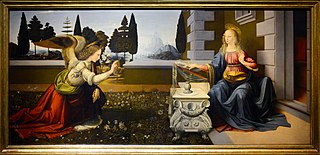
The Annunciation is a painting widely attributed to the Italian Renaissance artist Leonardo da Vinci, dated to c. 1472–1476. Leonardo's earliest extant major work, it was completed in Florence while he was an apprentice in the studio of Andrea del Verrocchio. The painting was made using oil and tempera on a large poplar panel and depicts the Annunciation, a popular biblical subject in 15th-century Florence. Since 1867 it has been housed in the Uffizi in Florence, the city where it was created. Though the work has been criticized for inaccuracies in its composition, it is among the best-known portrayals of the Annunciation in Christian art.

The Brancacci Chapel is a chapel in the Church of Santa Maria del Carmine in Florence, central Italy. It is sometimes called the "Sistine Chapel of the early Renaissance" for its painting cycle, among the most famous and influential of the period. Construction of the chapel was commissioned by Felice Brancacci and begun in 1422. The paintings were executed over the years 1425 to 1427. Public access is currently gained via the neighbouring convent, designed by Brunelleschi. The church and the chapel are treated as separate places to visit and as such have different opening times and it is quite difficult to see the rest of the church from the chapel.
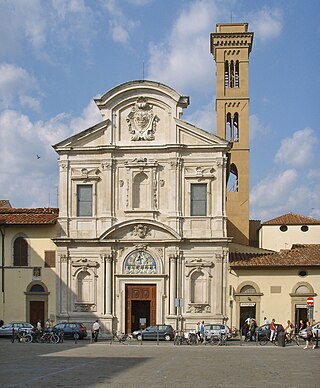
The chiesa di San Salvatore di Ognissanti, or more simply chiesa di Ognissanti, is a Franciscan church located on the piazza of the same name in central Florence, region of Tuscany, Italy. Founded by the lay order of the Umiliati, the church was dedicated to all the saints and martyrs, known and unknown.
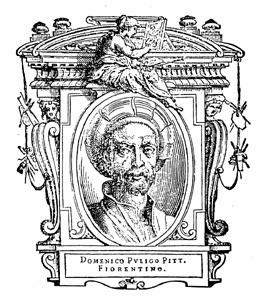
Domenico Puligo (1492–1527) was an Italian painter of the Renaissance, active in Florence. His real name was Domenico di Bartolomeo Ubaldini.

Florentine painting or the Florentine School refers to artists in, from, or influenced by the naturalistic style developed in Florence in the 14th century, largely through the efforts of Giotto di Bondone, and in the 15th century the leading school of Western painting. Some of the best known painters of the earlier Florentine School are Fra Angelico, Botticelli, Filippo Lippi, the Ghirlandaio family, Masolino, and Masaccio.

The Sassetti Chapel is a chapel in the basilica of Santa Trinita in Florence, Italy. It is especially notable for its frescoes of the Stories of St. Francis, considered Domenico Ghirlandaio's masterwork.

Italian Renaissance painting is the painting of the period beginning in the late 13th century and flourishing from the early 15th to late 16th centuries, occurring in the Italian Peninsula, which was at that time divided into many political states, some independent but others controlled by external powers. The painters of Renaissance Italy, although often attached to particular courts and with loyalties to particular towns, nonetheless wandered the length and breadth of Italy, often occupying a diplomatic status and disseminating artistic and philosophical ideas.
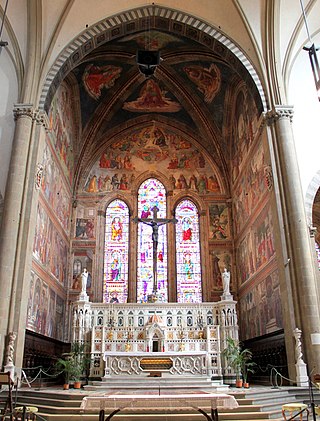
The Tornabuoni Chapel is the main chapel in the church of Santa Maria Novella, Florence, Italy. It is famous for the extensive and well-preserved fresco cycle on its walls, one of the most complete in the city, which was created by Domenico Ghirlandaio and his workshop between 1485 and 1490.

The Four Allegories is a series of four small panel paintings in the Gallerie dell'Accademia, Venice, Italy by the Italian Renaissance master Giovanni Bellini, whose date has been variously argued as different points in the range 1490–1504. They all measure 34 (Perseverance) or 32 × 22 cm in size.
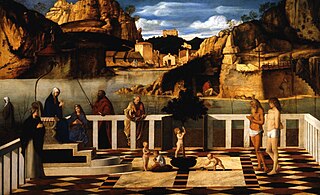
The Holy Allegory is a painting by the Italian Renaissance master Giovanni Bellini, dating from c. 1490 to 1500. It is in the Uffizi gallery in Florence, Italy.

Moses Leaving for Egypt is a fresco by the Italian Renaissance painter Pietro Perugino and his workshop, executed around 1482 and located in the Sistine Chapel, Rome. It depicts a journey by the prophet Moses.

The Adoration of the Magi is a painting by the Italian Renaissance master Domenico Ghirlandaio, executed around 1485–1488 and housed in the Ospedale degli Innocenti gallery in Florence, Italy. The predella, painted by Bartolomeo di Giovanni, is in the same site.

The Vocation of the Apostles is a fresco by the Italian Renaissance painter Domenico Ghirlandaio, executed in 1481–1482 and located in the Sistine Chapel, Rome. It depicts the Gospel narrative of Jesus Christ calling Peter and Andrew to become his disciples.

An Old Man and his Grandson is a ca. 1490 tempera painting by the Italian Renaissance artist Domenico Ghirlandaio. One of Ghirlandaio's best-known works, it is considered notable for its emotional poignancy. Its realism has been described as unique among the portraits of the Quattrocento.

The Saint Fina Chapel is an Early Renaissance chapel in the right aisle of the Collegiate church of Santa Maria Assunta, located in San Gimignano, Tuscany, Italy. It was designed by Giuliano and Benedetto da Maiano in 1468 to enshrine the relics of Saint Fina. The side walls of the chapel are painted in fresco by Domenico Ghirlandaio with two scenes from her life, executed between 1477 and 1478.

Portrait of a Man is a c. 1478 painting by the Italian Renaissance painter Domenico Ghirlandaio (1449–1494) executed in tempera on wood.




















